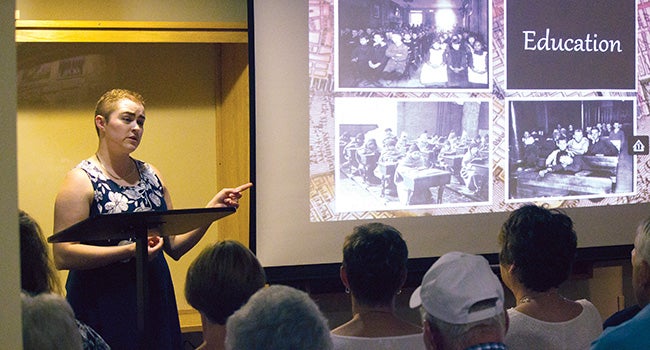Museum hosts program dedicated to Orphan Train
Published 10:34 am Monday, September 25, 2017

- Shaley George, curator of the National Orphan Train Complex, delivers a presentation on the history of the Orphan Train program at the Dowagiac Area History Museum Saturday. (Leader photo/TED YOAKUM)
DOWAGIAC — During the late evening hours of Sunday, Oct. 1, 1854, a group of 45 children, ranging from 7 to 15 years old, and a single caretaker named E. P. Smith, arrived at a train depot in a small Midwest city known as Dowagiac, Michigan.
After bribing the stationmaster — who was used to seeing around three passengers come through the small depot on daily basis — to allow them to spend the night, Smith and the group of children had a well-deserved rest on the floor of the station, weary from their exhausting trip from New York City, which involved traveling on two trains and two boats.
Upon opening the doors of the station the following morning, Smith was bombarded by a flood of eager children pouring out of the building, wanting to witness the sights and sounds of the country side for the first time in their young lives.
While losing track of nearly 50 children would cause most people to have the mother of all panic attacks, the experience had become old hat for Smith, who casually strolled down to one of the local hotels to check in. Eventually, the wayward children found their way to back to their caretaker — it was breakfast time, after all — joining him at the hotel.
All but one, that is: a boy named George, who ended up getting lost for two days before he was reunited with the rest of children, much to relief of his little brother.
“They [the children] can survive in the city, but they got to the country, [it] threw them for a loop,” said Shaley George, a historian hailing from Concordia, Kansas. “They just didn’t know what to do.”
This group of children did not come to the unfamiliar streets of Dowagiac merely to do some sightseeing. They came to find new lives and — more importantly — a family who would show them the love and care they never received while living in the streets of New York City.
Their trip was the first of many organized by what would later be known as the Orphan Train program, an initiative that would relocate 200,000 homeless and abandoned children from the city to homes across the Midwest and beyond. In the process, it would change the face of the foster care system forever.
George, the curator of the National Orphan Train Complex, described the fateful first trip of the Orphan Train during her presentation Saturday at the Dowagiac Area History Museum, where they city hosted its first ever reunion for descendants of Orphan Train riders. Around 100 people attended the ceremony, including several whose family tree contains people who once hopped aboard one of the trains to find a new home.
The reunion was the penultimate event in the city’s yearlong commemoration of the historic maiden voyage of the Orphan Train, the centerpiece of which is a mural depicting the 1854 arrival of the train in Dowagiac, located downtown on Pennsylvania Avenue. The piece of public artwork, created by Cassopolis artist Ruth Andrews with the assistance of around 50 volunteers, will be dedicated during a ceremony at 1 p.m. Saturday, Oct. 14, during the city’s Under the Harvest Moon Festival.
George, whose own lineage contains a former Orphan Train rider, said she was excited to have the opportunity to visit the city that welcomed the first batch of 45 orphans nearly 163 years ago.
The Orphan Train program was the brainchild of famous philanthropist Charles Loring Brace, whose organization, the Children’s Aid Society, sponsored the first trip.
Brace, a Protestant minister, had dedicated his life to improving the living conditions of orphaned children in New York City — in 1854, around 30,000 children were living on the streets on the city. The only alternative for children living in the elements those days were either taking their chances residing alongside adults inside the city’s poor houses, or taking refuge at of the city’s many orphanages — which, in spite of their impressive gothic-inspired architecture, were places of misery and neglect for residents.
“When you filled out a census report for an orphanage, you didn’t call the children ‘boarders’ or ‘students’ — you called them ‘inmates,’” George said. “When turned 18, they would sometimes join a gang of kids about their age. Then they would end in prison, and really become inmates. We told them what they were from the very beginning. So what was their future going to be?”
While Brace’s “newsboys’ lodging-houses” were more focused on the welfare of the children living there — for example, they opened up savings accounts for children, so they would not have to worry about guarding their money while they slept at night — the philanthropist recognized that, without growing up with actual parents and siblings, they would be not likely to know how to become good parents themselves when they eventually started a family.
With the monetary support of some of the country’s most powerful families, Brace set out to relocate a group of 46 children to new homes in Midwest, which he believed would provide them with stable homes — and Brace selected the city of Dowagiac, Michigan, to be the program’s first stop.
The group — who only had a single pair of clothes with them — first took a boat from New York City to Albany, where two children were adopted right off the bat, while another street child joined the party. From there, they boarded a train heading to Buffalo, during which the children were welcomed with a new sight the moment they opened up the train car doors.
“It was the first time they had ever seen farm fields — and they went ballistic,” George said. “They were so excited. I could imagine E. P. Smith grabbing kids and trying to hold on to them while they shouted ‘cow!’”
The group then took another boat, crossing through Lake Erie to a port in Detroit. Unbeknownst to Smith and Brace, the children were boarded in the lowest section of the ship — beneath the live stock, which were placed on a grate above with open slots.
After arriving at the port, the children joined Smith top side — where, shortly thereafter, three bushels of peaches went missing.
“The kids denied [taking them], and E.P. Smith believed them,” George said. “The captain eventually believed them, too. Later on, Smith found out that the kids actually took them — which they deserved, for the ride they endured.”
From Detroit, the group took one last train ride, that took them to their destination: Dowagiac.
All 45 children found new homes following their arduous journey. All but a few were taken in by local families, with the remaining children transported to Iowa, where they were taken in by an orphanage in Iowa City.
In spite of the all the issues, Brace considered the first Orphan Train trip a success. Using the lessons they learned, the program continued through 1929, relocating thousands of children to new homes.
Today, it is estimated that 4 million Americans — or 1 in 25 — have someone in their family trees who were relocated through the program.
As a special present to the museum, George and another Orphan Train expert, Clark Kidder, showed off a banner that displayed more than 30 names of riders of the inaugural Orphan Train. It was the first time in 163 years that these names were displayed to the public, they said.





